Xiaomi Router R2D with terabyte disk
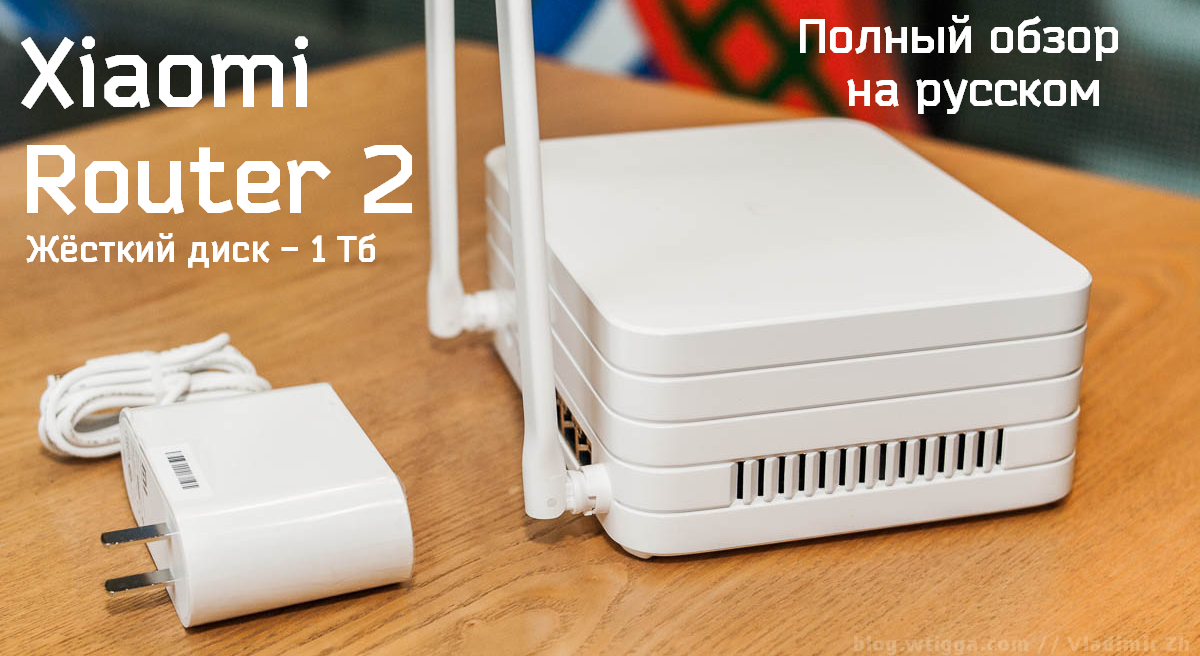
In addition to smartphones, home electronics and wearable devices, Xiaomi ( xiao mi , emphasis on the last syllable ) also has routers. Both small and budget, and large and relatively expensive. That's about the latter, with a built-in disk for a terabyte , and it will be discussed. He also knows how to pretend to be a Time Capsule for Mac.
Xiaomi Router 1TB (or 小米 路由器 硬盘 版 1TB, or Xiaomi Router 2 ) is a home router with a built-in hard drive that can both distribute the Internet and perform the functions of a network storage ( NAS ), and also has a whole bunch of other useful and not very features. Official priceinside the PRC - 699 yuan , or about 7,700 rubles. at today's rate. For sellers on AliExpress, prices with delivery start at 11 thousand rubles (for sale). There is also a 6 TB model, but they cost a bit too much (2999 yuan, or almost 33 thousand rubles before the extra charge), and no one hurries to bring them to Russia.
The filling of the router is not weak.
Specifications
Processor: BCM4709C Cortex-A9, 2 cores of 1.4 GHz each
Internal memory: 512 MB SLC Nand Flash (in many reviews it is considered that this is the amount of RAM; actually it is less)
RAM: 256MB DDR3-1600
HDD: 3.5 "(1 Tb)
Antennas: 2xPCB (2.4G to 4dBi, 5G to 6dBi)
2.4 GHz Wi-Fi 2 * 2 (IEEE 802.11N up to 300 Mbps)
5 GHz Wi-Fi 2 * 2 (IEEE 802.11AC up to 867 Mbps )
IEEE 802.11a / b / g / n / ac , IEEE 802.3 / 3u / 3ab
2.4 GHz channels : 1,2,3,4,5,6,7,8,9,10,11,12,13
5 GHz
channels : 149,153,157,161,165 5GHz DFS channels : 36,40,44,48,52,56, 60.64
Protocols:
11b: DSSS : DBPSK (1Mbps), DQPSK (2Mbps),
CCK (5.5 / 11Mbps)
11a / g: OFDM: BPSK (6 / 9Mbps),
QPSK (12 / 18Mbps), 16QAM (24 / 36Mbps ),
64QAM (48 / 54Mbps)
11n: MIMO-OFDM: BPSK, QPSK, 16QAM, 64QAM.
11ac: MIMO-OFDM: BPSK,
QPSK, 16QAM, 64QAM, 256QAM.
Antenna Sensitivity:
11Mbps: ≤-90dBm, 54 Mbps: ≤-72dBm,
HT20 MCS7: ≤-69dBm,
HT40 MCS7: ≤-66dBm,
VHT20 MCS8: ≤-65dBm,
VHT40 MCS9: ≤-60dBm,
VHT80 MCS9: ≤-58 dBm
1 x USB 2.0 (DC output : 5V / 1A)
3 x Gbit Ethernet (Auto MDI / MDIX)
1 x Gbit WAN (Auto MDI / MDIX)
1 LED (red / blue / yellow)
Reset
button
Power button : 12V 3A

Package Contents :
Instruction, 1 pc.
Warranty card, 1 pc.
Power adapter 12V / 3A, 1 pc.
Unpacking
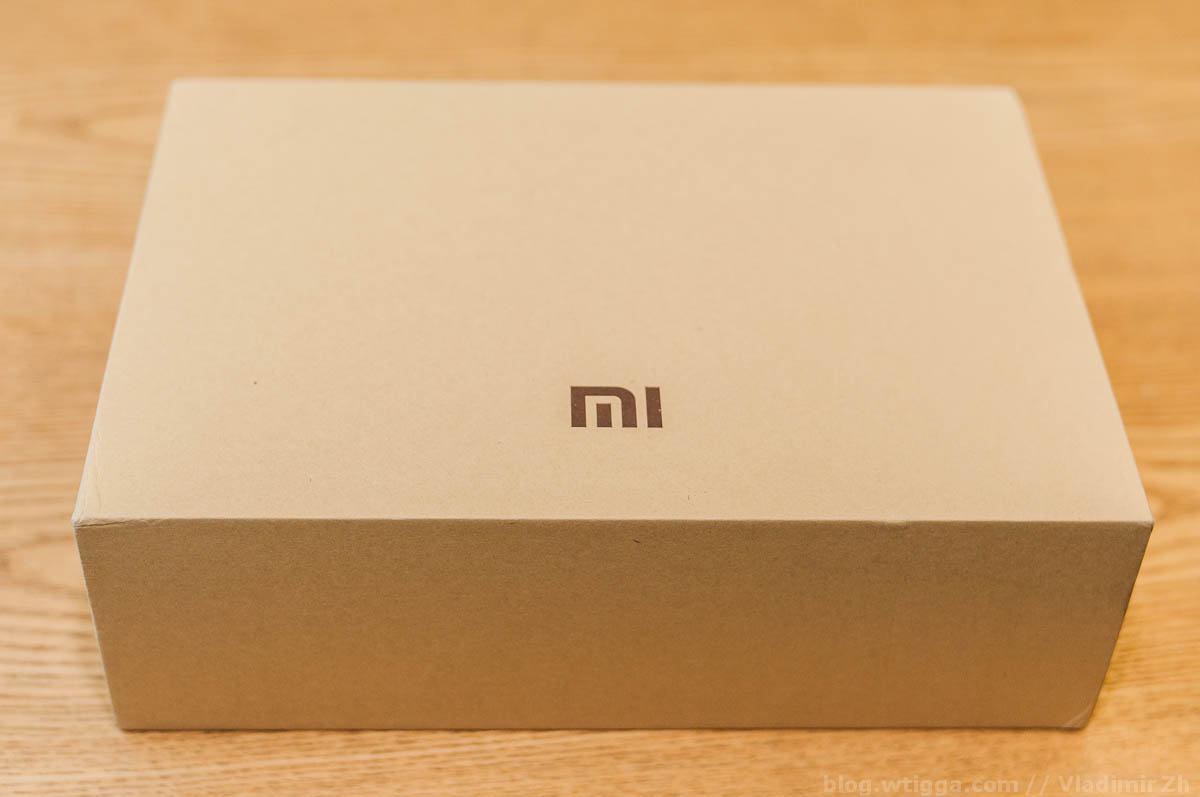 Traditional laconic eco-friendly packaging of Xiaomi products
Traditional laconic eco-friendly packaging of Xiaomi products  Inside everything is white, with a hint of one company An
Inside everything is white, with a hint of one company An  ascetic set: router, power supply, instruction in English
ascetic set: router, power supply, instruction in English 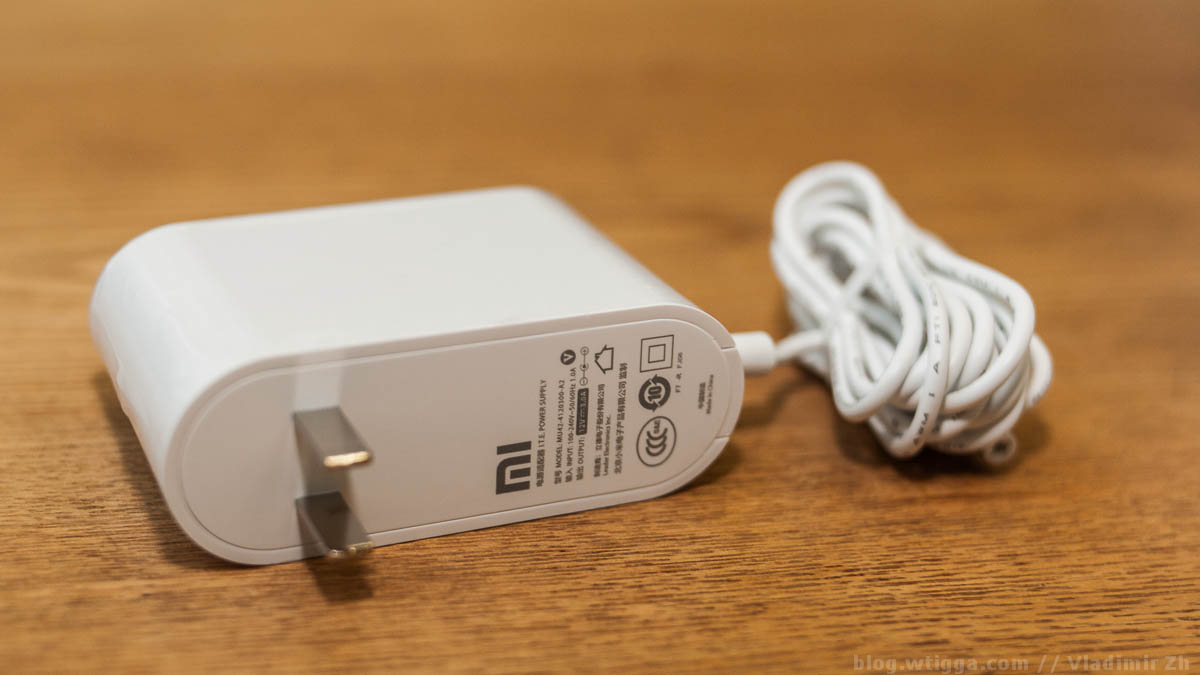 12V / 3A adapter
12V / 3A adapter  Short instruction completely in English, the first time I see something like this with Xiaomi. However, the languages will be lower.
Short instruction completely in English, the first time I see something like this with Xiaomi. However, the languages will be lower. 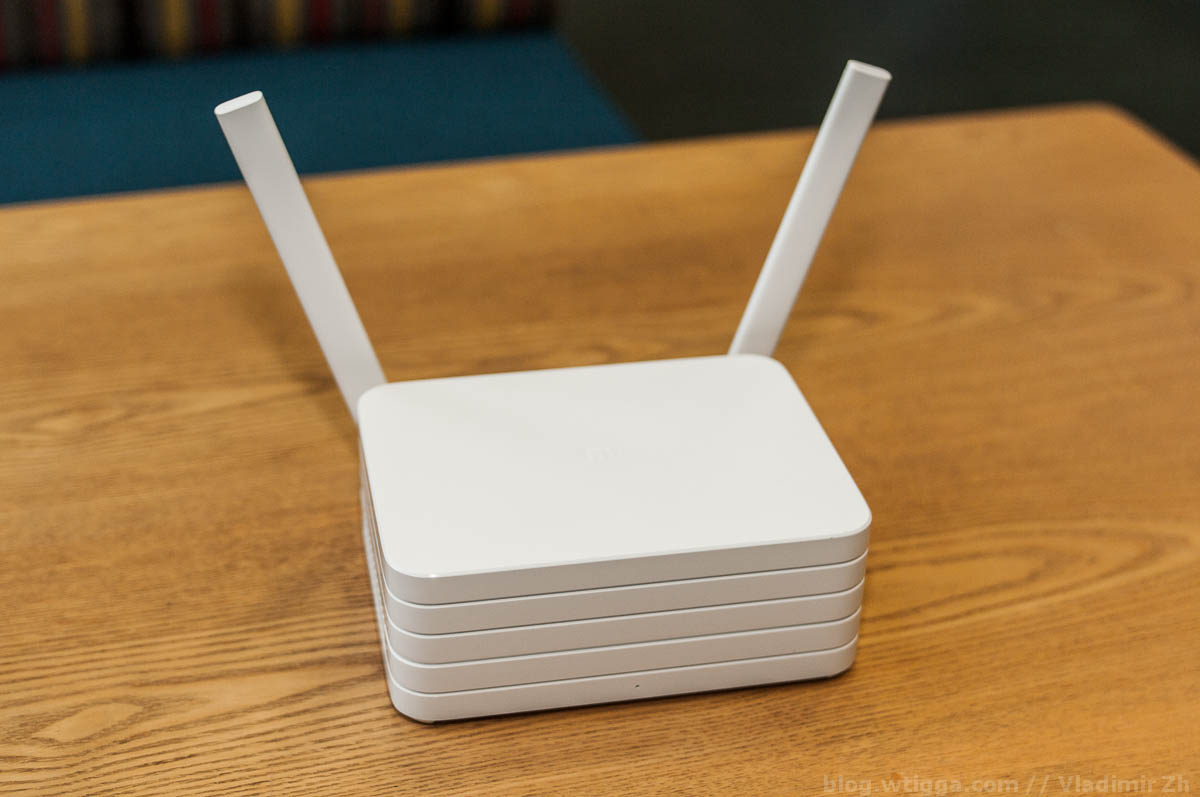 Simple and concise design
Simple and concise design  From left to right: antenna No. 1, reset button, power port, power button, USB 2.0 port, three 1 Gbit Ethernet LAN ports, 1 1 Gbit Ethernet WAN port, antenna No. 2
From left to right: antenna No. 1, reset button, power port, power button, USB 2.0 port, three 1 Gbit Ethernet LAN ports, 1 1 Gbit Ethernet WAN port, antenna No. 2 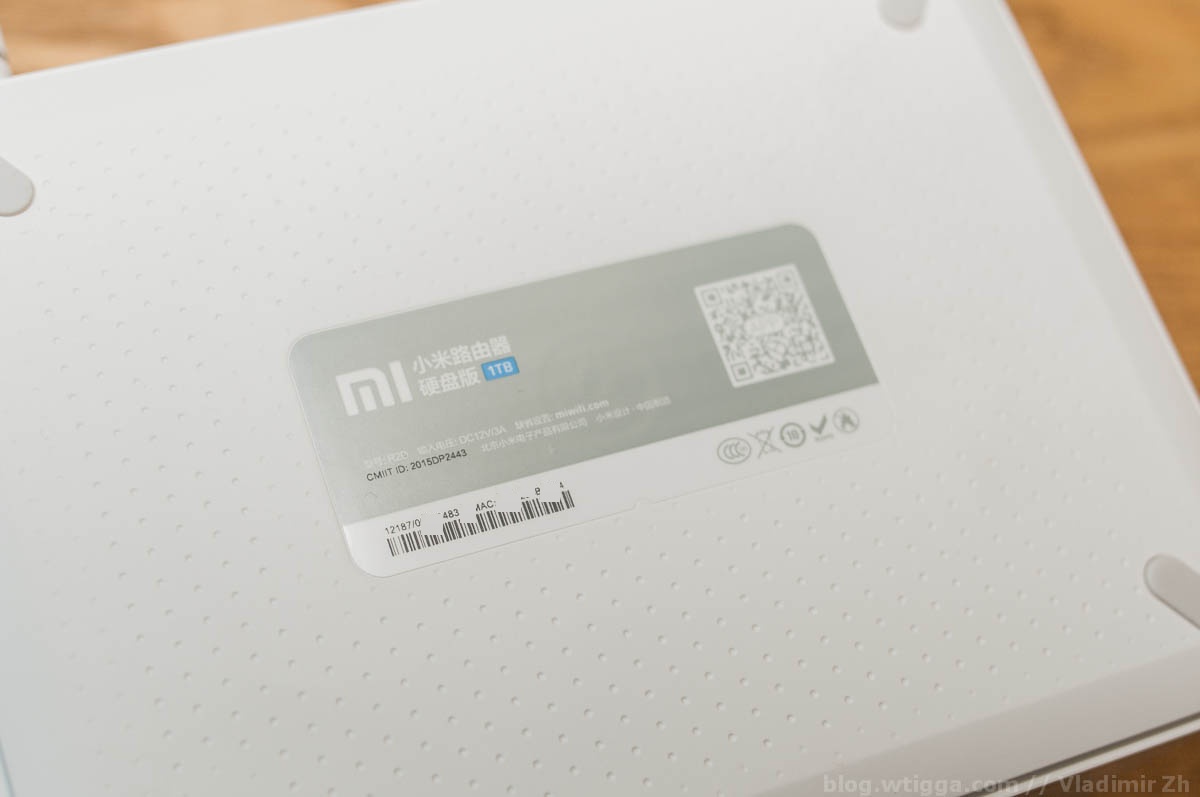 Serial number, model name and QR code to install the application
Serial number, model name and QR code to install the application 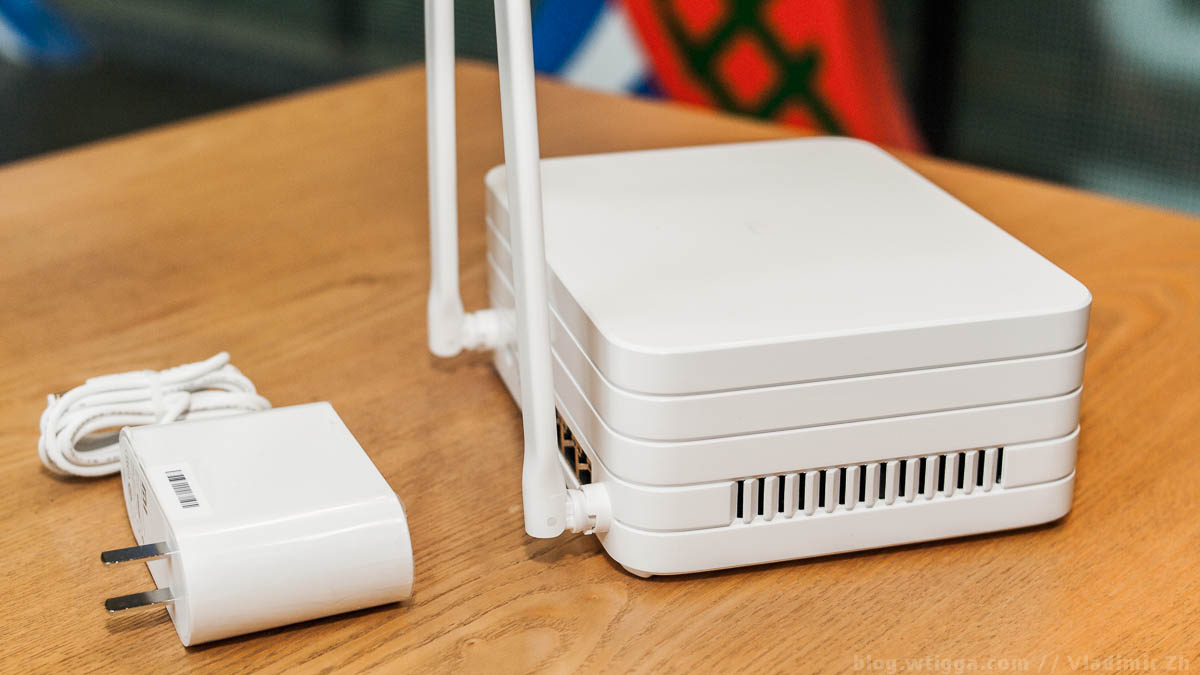 On the sides are ventilation holes (very necessary)
On the sides are ventilation holes (very necessary)What's inside?
Erotic Time!
 The screws are under four soft legs.
The screws are under four soft legs.  One of them is marked with a warranty sticker (I had to tear it off, curiosity took it)
One of them is marked with a warranty sticker (I had to tear it off, curiosity took it)  Nobody thought about the appearance of the plastic cover. Before us is an iron basket for a hard disk with ventilation.
Nobody thought about the appearance of the plastic cover. Before us is an iron basket for a hard disk with ventilation. 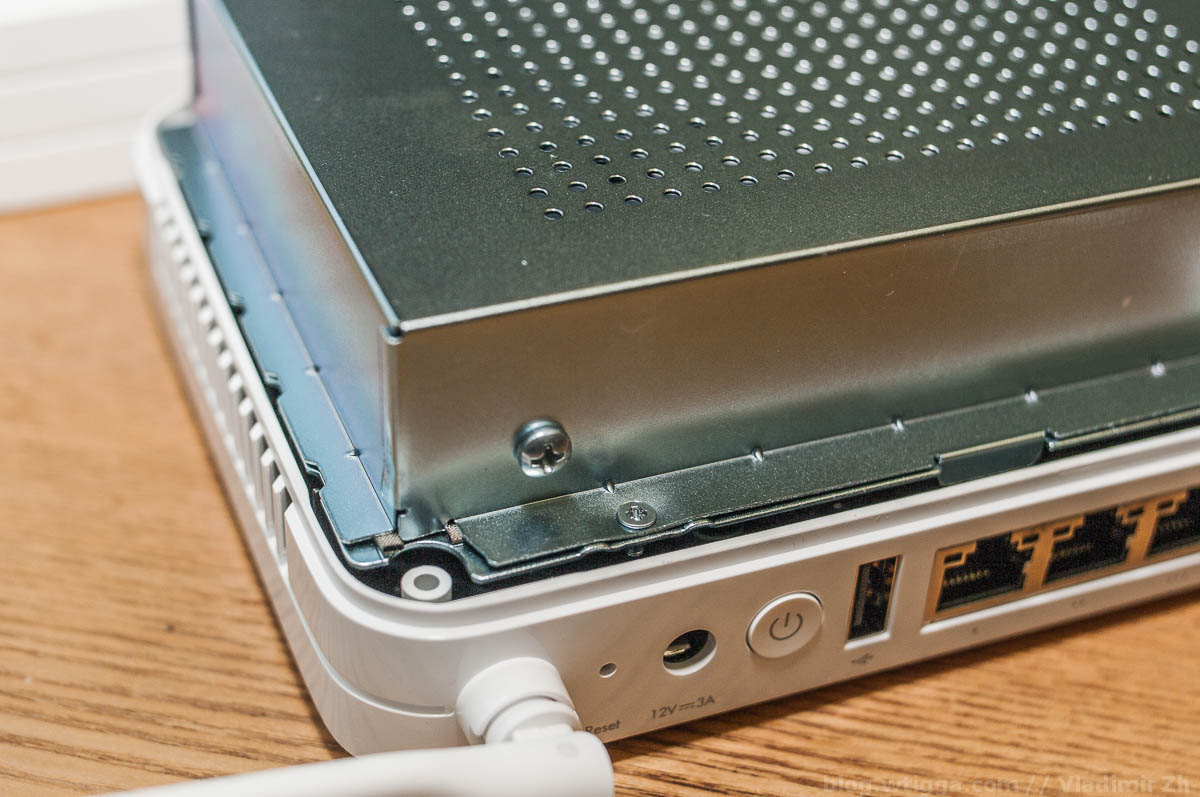 Four larger screws hold the hard drive itself.
Four larger screws hold the hard drive itself.  The cap at the end behind two screws hides a SATA cable underneath.
The cap at the end behind two screws hides a SATA cable underneath. 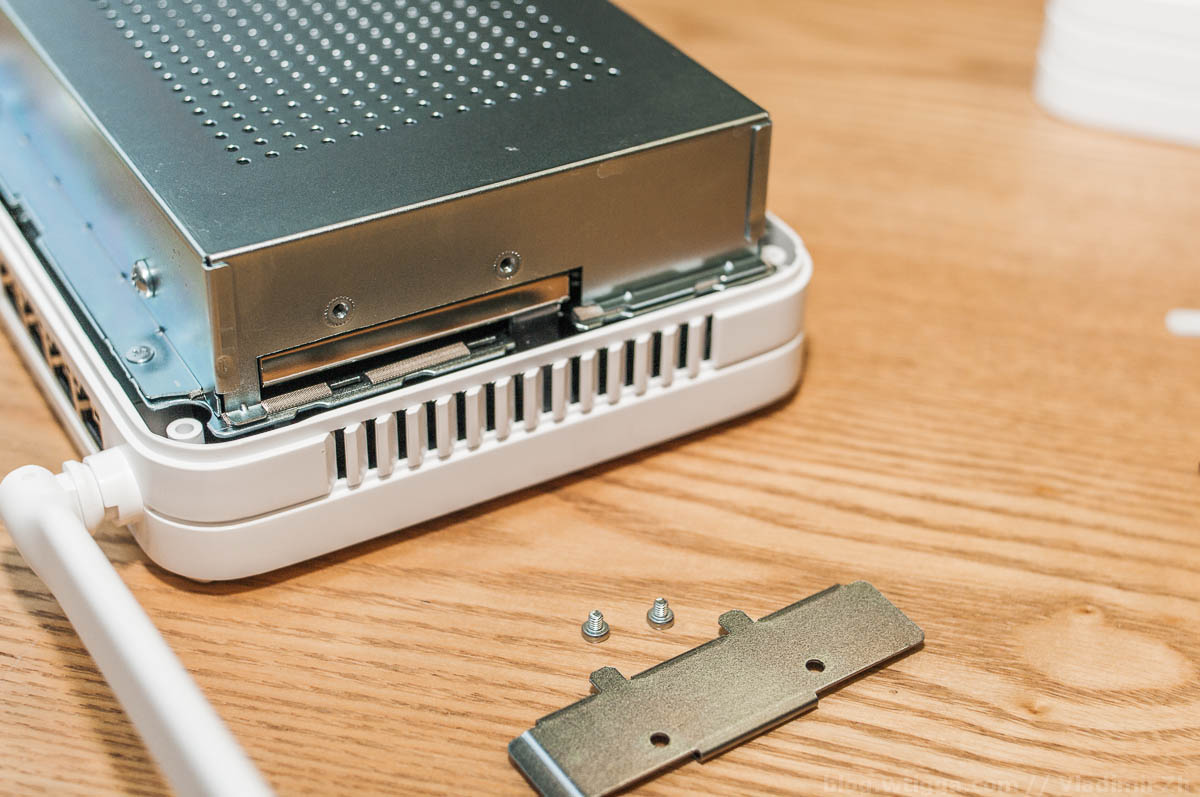 ... however, it will not work to disconnect it without removing the entire cover, so the purpose of the removable cover remains a mystery to me.
... however, it will not work to disconnect it without removing the entire cover, so the purpose of the removable cover remains a mystery to me.  You need to remove the hard drive carefully so as not to break the thin cable.
You need to remove the hard drive carefully so as not to break the thin cable. 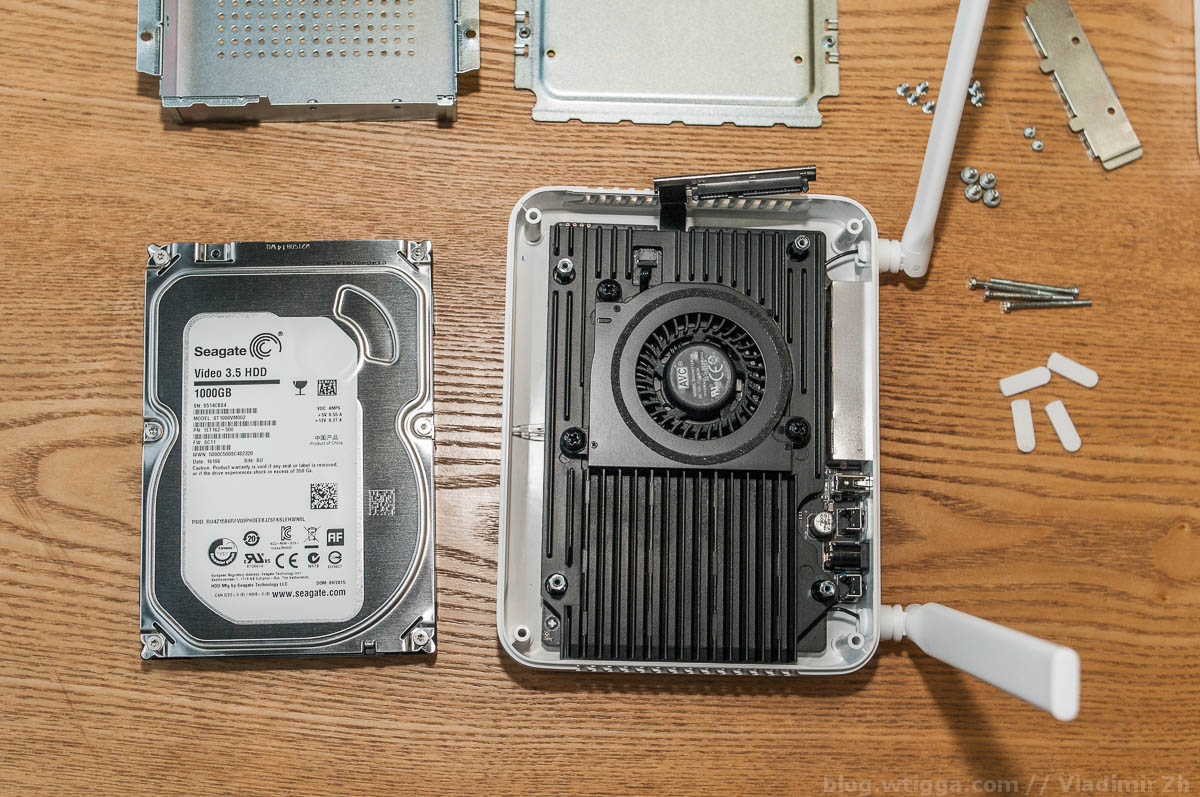 Inside installed a 3.5 " Seagate Video Series disc of 1 TB.
Inside installed a 3.5 " Seagate Video Series disc of 1 TB. The main board is hidden under a large metal radiator with a cooler. She holds with glue and thermal paste, so I decided not to take it off.
The main board is hidden under a large metal radiator with a cooler. She holds with glue and thermal paste, so I decided not to take it off.Functions
The seller, from whom I have a router, is selling the initially English version. This means that immediately installed international firmware with a fully English web-based admin area, and this is a big plus for many buyers. It is enough to go to the admin panel at the standard address 192.168.31.1 , and enter the password for the access point specified during the initial setup - and you have all the standard router settings.
What is out of the box?
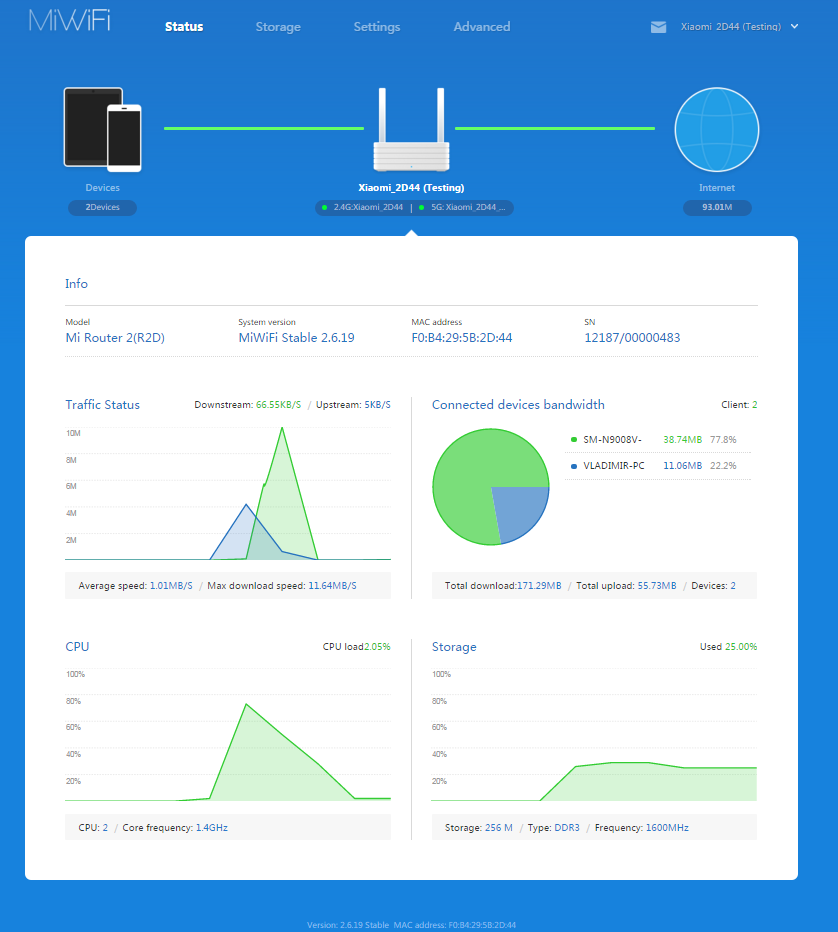
Without installing plugins (see below), the following settings are available through the web interface:
- Wi-Fi:
setting up two channels of 2.4 and 5 GHz, the ability to enable a “single access point” with two frequencies (the device itself will select the desired protocol);
guest access point with a separate password and limited access to local resources; - WAN / LAN:
IP address
DHCP mode
DDNS setting
port forwarding
DMZ mode, QoS
port speed (100/1000 Mbps)
MAC address change device
filtering by MAC VPN
provider speed test
(PPTP / L2TP) - Disk space
formatting the internal disk
enabling sleep mode (stopping the disk when idle)
checking disk health
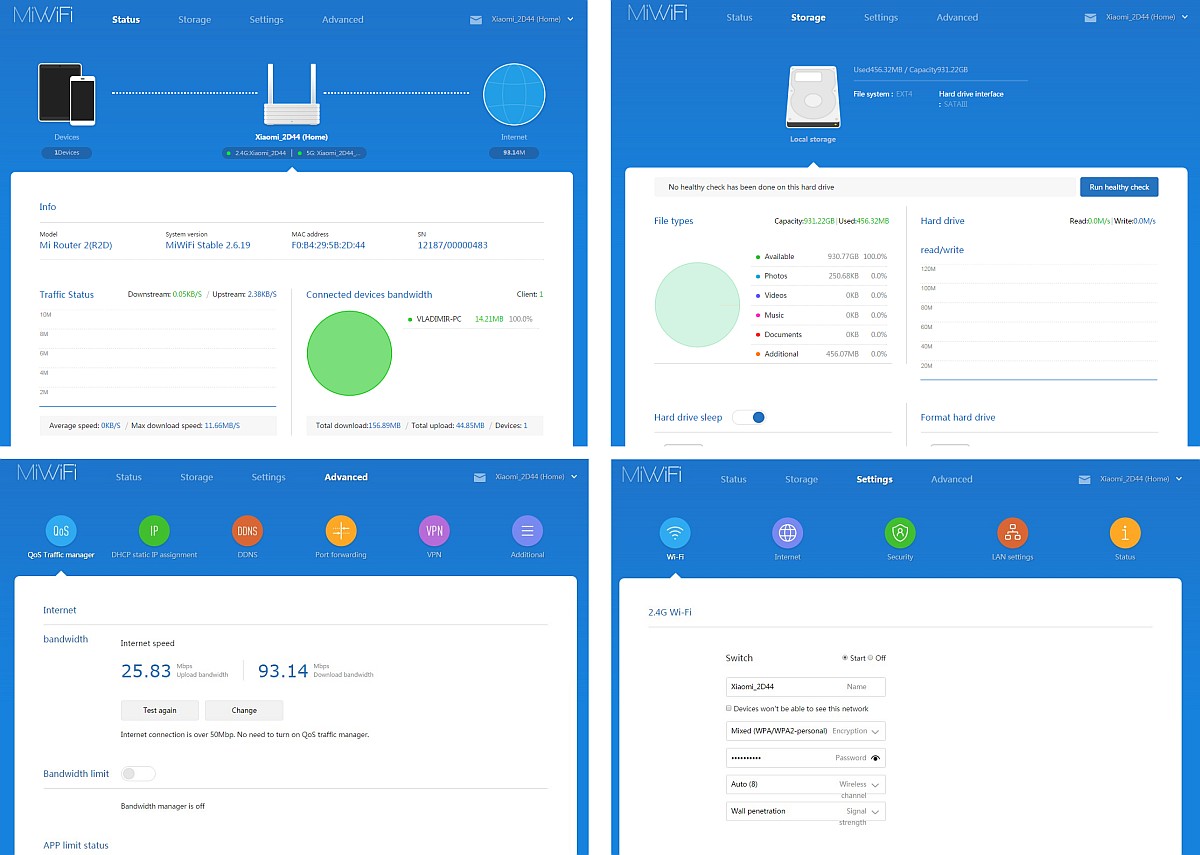
In short, everything is standard, nothing is missing, but there is nothing to brag about. The firmware is based on OpenWRT and is slightly poorer than the original. Interesting starts in plugins ...
application
The easiest way is to configure the router through the Xiaomi proprietary application, which can be downloaded by scanning the QR code at the bottom of the router (or from the official website ). Insert the cable from your provider, and it will quickly pick up the device you just turned on and navigate through the setup wizard.

1) Click “Set up a new router”; 2) Connect to a new router; 3) Choose the location of the router
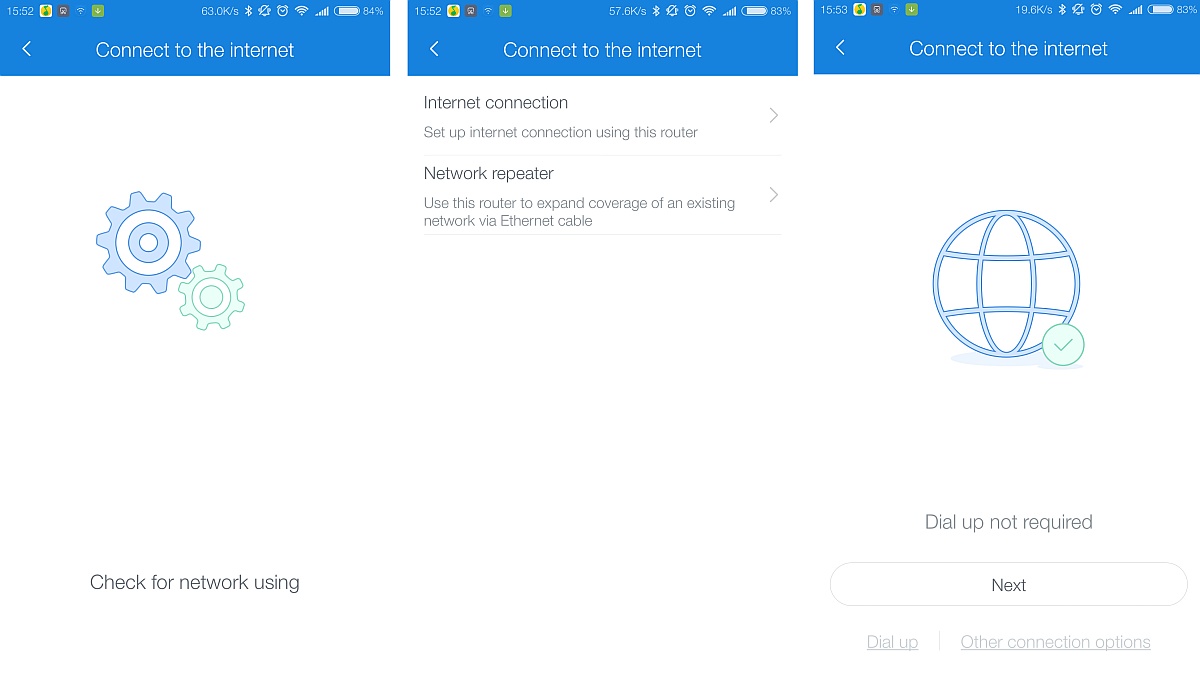
4) Expect; 5) Select an operating mode; 6) Set up the connection of the provider
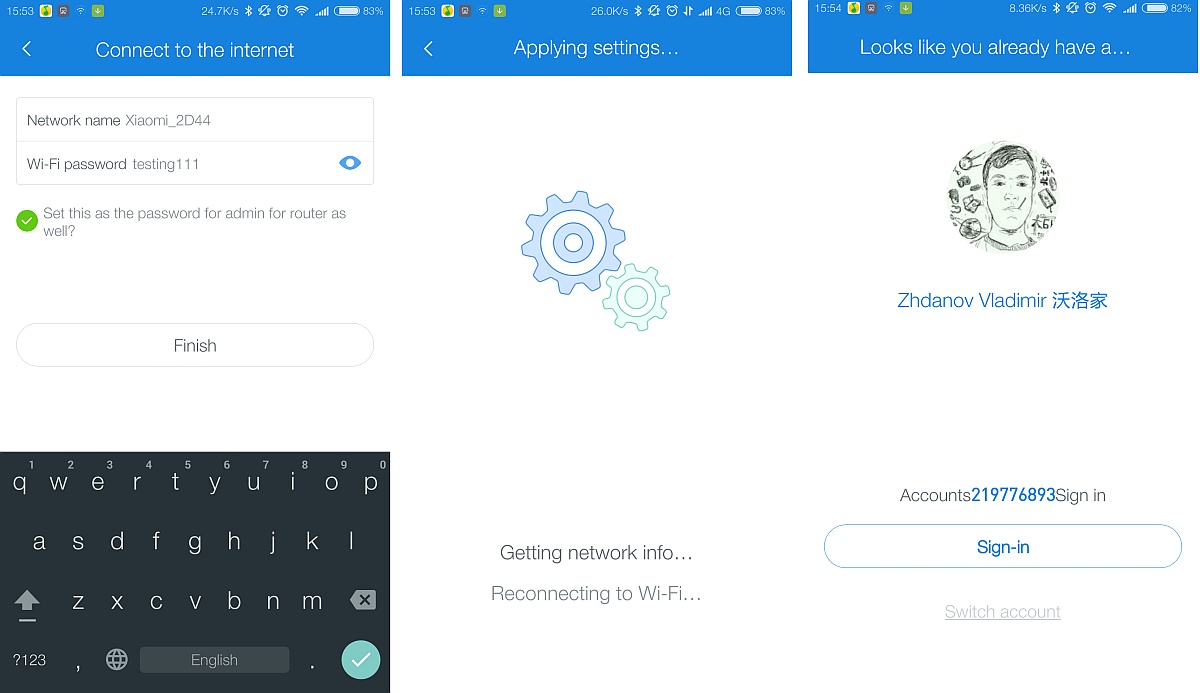
7) Set the name and password for the access point; 8) Wait; 9) If you wish, you can log in to your Xiaomi account.

At the last stage, you will be shown three slides praising the router.
That's it, the setup is finished, you can use it.
network storage
It works right away and by default it is on 192.168.31.1 or through a network environment in Windows.

Initially, there is already a division into thematic directories. The minimum speed for copying files to a NAS over a wireless network was 128 Mbps .
 Remember that one megabyte (MB) is equal to 8 megabytes (Mb).
Remember that one megabyte (MB) is equal to 8 megabytes (Mb). The average speed was about 35-40 MB ( 280-320 Mb ), but it was probably not limited to the fastest disk of my PC.
Signal and stability
For a week of use, the router did not hang once. It was constantly connected 10-12 devices (laptops, tablets, smart home elements). The connection is stable, there were no breaks. Wi-Fi speed tests show the maximum of my wired connection:

However, the only time there was a subsidence of speed to zero for several seconds when copying a video file from a PC to a router, but then everything went smoothly and there were no such problems. Probably the reason for this is the developer firmware (about it below).
The signal was easily caught within several rooms.
Plugins
A separate discussion will be about plugins. They add various interesting functions to the router and are installed through the mobile application. A short list of what is available today:
- DLNA
- SAMBA
- Transmission BitTorrent
- Mac Time Capsule (backup via Time Machine )
- Built-in HDD backup
- Speeding up downloads through Xunlei (Thunder)
- Scheduled reboot or startup
- Backup photo from Android smartphone
- Full smartphone backup on MIUI (Xiaomi)
- ... and other Chinese-oriented plugins (faster loading of Baidu pages , pre-downloading updates for games, and so on).
But! If the application itself is more or less translated ...

... then almost all the plugins are in Chinese .
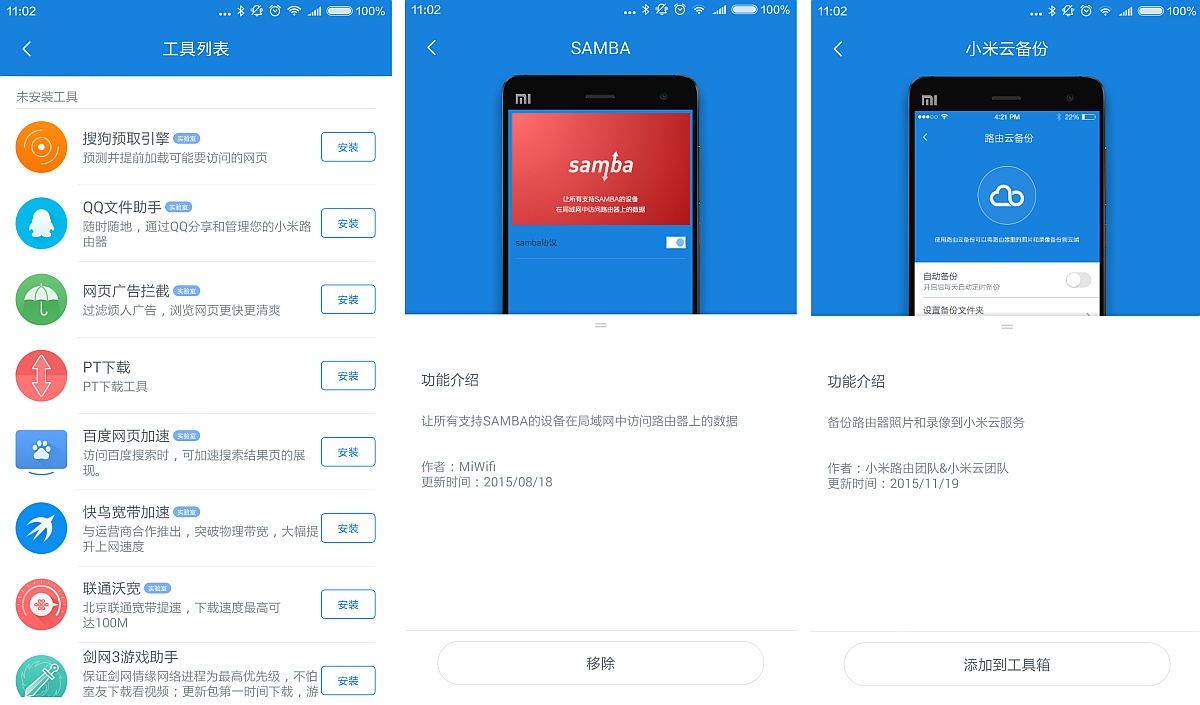
If you don’t know the language, then you can try to install and configure them using the scientific poke method, since you can guess a lot just by appearance. But still unpleasant.
Most of the interesting functions out of the box do not work, but I really wanted to try at least a backup for Macs!
How to enable Time Machine?
Before you force your Mac to look for an available copy space, you must install the plugin.
- Install “Mac Backup” (Mac 备份 助手) through the official smartphone application.

2. Run Time Machine on a Mac, and it will immediately find the router’s disk called MacBackup.

3. Through the disk utility, we divide the router’s disk into two partitions (for system backup and data storage)
4. Format the partitions in HFS and set the labels.
5. Select the data for backup (you can leave only the system).
6. The first backup will be long, the subsequent ones will be incremental, ie only what has changed will be transmitted over the network. New data will overwrite old data.
That's all, Mac backups are configured.
SSH access to the router (and a few words about Chinese surveillance)
Since the router has a modified version of OpenWRT inside, which, in turn, is based on Linux, the router can be controlled via SSH.
- Set up the router and link it to your Xiaomi account (required);
- Update the firmware to development . The official page with firmware is here ;

- Now, through the web admin in the Settings -> Status section, you can manually download the firmware file to the router and start the update.
ATTENTION : after this, the firmware (and admin panel) will be in Chinese; - Go to http://d.miwifi.com/rom/ssh , and logging into your Xiaomi account, you will see this window in front of you:
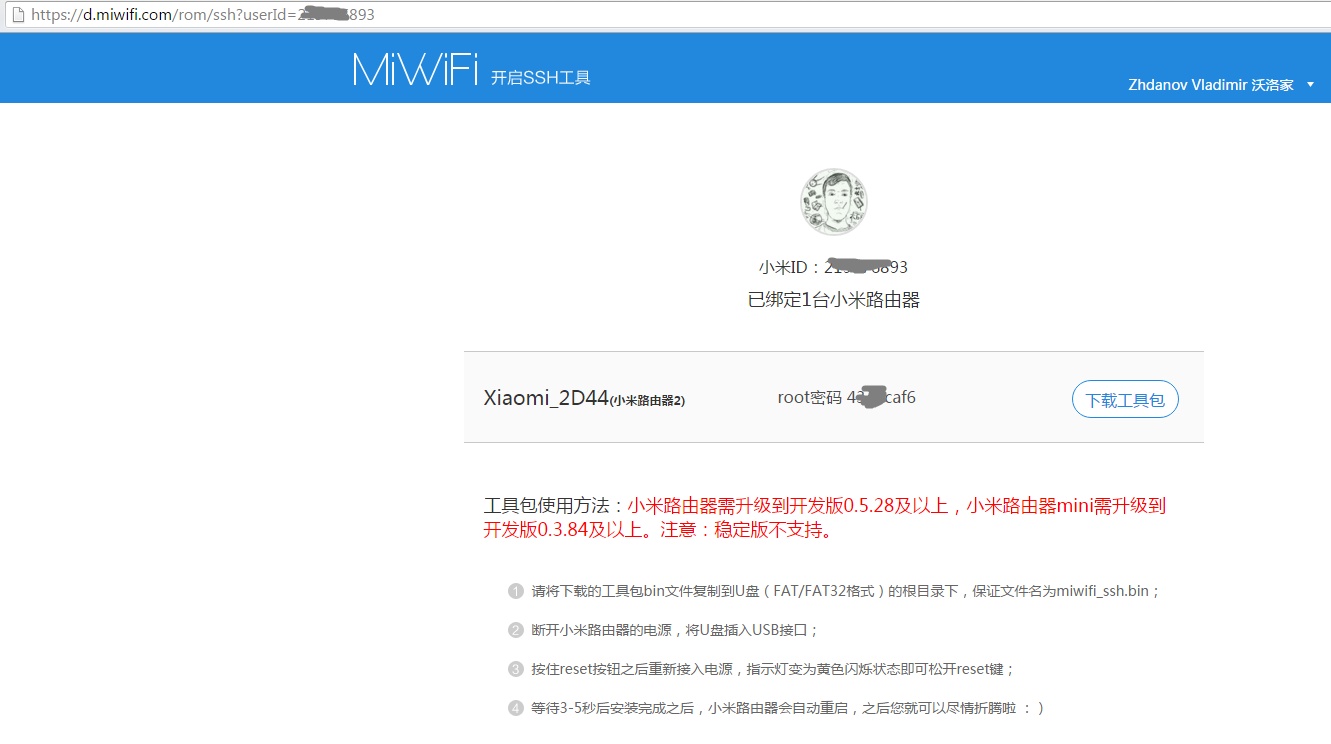
- In the center of the screen after the words " root 密码 " will be your root password from the router. Write it to yourself;
Yes, Xiaomi stores the password on its servers.
If you have the beginnings of paranoia, you should consider whether you want to make a copy of your Mac on a device to which the Chinese developer theoretically has direct access. Either dig deep into the system and close such holes. - In the same window, download the miwifi_ssh.bin file using the blue button opposite the root password;

- Format any flash drive in FAT32 , write to it mifiwi_ssh.bin;
- Turn off the router, connect a USB flash drive to it, hold down the reset button ( RESET ) and, without releasing , turn on the router;
- Wait until the LED flashes orange , and release the reset button;
- Wait until the LED turns blue . Disconnect the USB flash drive.
Now you have Chinese development firmware and open SSH. You can connect to the router through Putty or WinSCP .

Host - miwifi.com
Login - root
Password - which you received at stage number 4.
What can be done with such wealth is a topic for a whole forum thread, for example, on w3bsit3-dns.com , where there are many recipes for the advanced use of the router.
Conclusion
As with most Xiaomi technology, to the fullest it reveals itself in the homeland. Despite the powerful stuffing and some kind of infrastructure created around the device, most are focused on Chinese realities and / or Chinese. Therefore, to get the most out of it, you will have to make some efforts.
+ Powerful stuffing
+ OpenWRT
+ 1TB hard drive
+ Access to SSH
+ Many additional features
- Poor localization
- Root password is available to the Chinese
- Requires some technical skills
A separate conversation about the price. Almost half of its cost is a terabyte hard drive: a similar Seagate in retail today costs about 5 thousand rubles. The remaining 3-6 thousand rubles (depending on the place of purchase) you get a device with a dual-core 1.2 GHz processor, 256 megabytes of RAM and an OpenWRT system, not to mention dual-band Wi-Fi and gigabit ports. Let me remind you that in China on the official website of Xiaomi it costs 699 yuan, and the sellers for our customers - from 11 thousand .
By the way, the router works silently . The hum of the fan and the creaking of the hard disk can be heard only by lifting the ear directly to the ventilation holes.
"... Think for yourself, decide for yourself to have or not to have."
